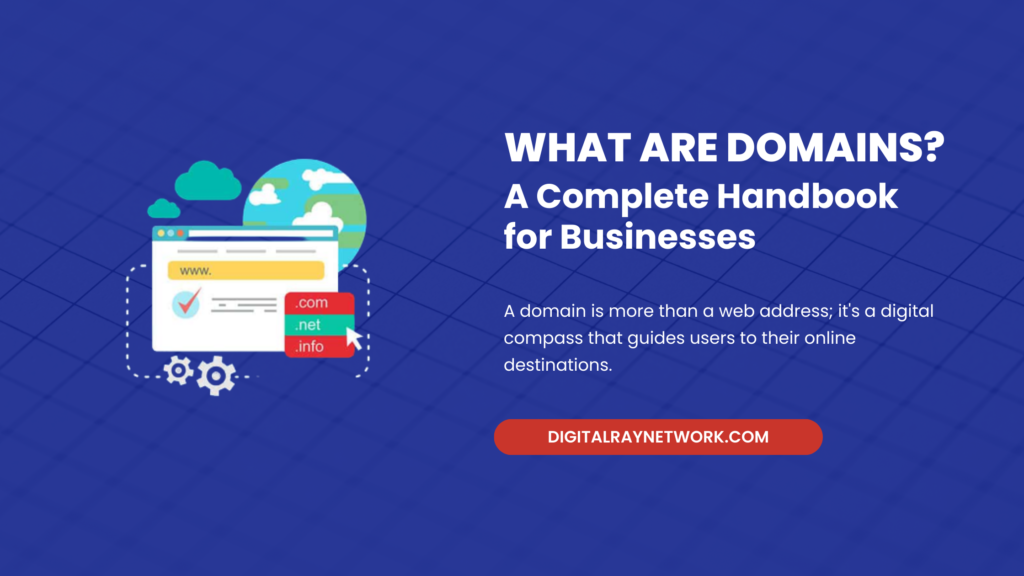Understanding Domains
Defining a Domain
A domain is more than a web address; it’s a digital compass that guides users to their online destinations. It’s a unique moniker that helps individuals navigate the vast web landscape. Businesses leverage domain names to simplify their online presence, enabling customers to effortlessly explore their websites and digital storefronts. The accessibility of a business website significantly hinges on the ease with which its domain name can be discovered.
The origin of domain names dates back to the early 1980s when a revolutionary concept emerged – simplifying internet addresses. This innovation aimed to correlate an IP address with a memorable word or phrase, eliminating the need to grapple with strings of digits. The evolution of domain names has brought them into various roles, including website and email addresses, as well as corporate identification. Today, the process of registering a domain has become more accessible and budget-friendly, making it attainable for a broader audience. This comprehensive guide unveils the essence of domain names, encompassing aspects like TLDs, domain administration, and more.
Unveiling the Components of Domain Names
Deconstructing Domain Names
A domain name is composed of four pivotal components, each playing a distinct role in the web ecosystem:
Second-Level Domain (SLD): At the forefront of the domain name, the SLD (e.g., ‘google’ in ‘google.com’) acts as the core identifier. Opting for a memorable SLD simplifies user recall and fosters online accessibility.
Top-Level Domain (TLD): Concluding the domain name, the TLD (e.g., ‘.com’ in ‘google.com’) holds sway in the internet hierarchy. Diverse TLD options cater to distinct markets or industries, offering tailored targeting.
Subdomain: A flexible prefix such as ‘blog’ in ‘blog.google.com’ serves as a subdomain. It effectively organizes website content, directing users to specific sections or functionalities.
Root Domain: Often represented as a trailing dot, the root domain is the apex of the hierarchy. Though unseen by users, it signifies the utmost level of domain structure.
Navigating Top-Level Domains (TLDs)
Delving into TLDs
TLDs dictate the zenith of domain hierarchy, encompassing various categories to suit diverse needs. The following delineates different TLD categories, aiding you in selecting the perfect match for your business:
Generic Top-Level Domains (gTLDs): Prominent gTLDs such as .com, .org, and .net boast universal recognition and broad appeal. They seamlessly integrate into business identities.
Country Code Top-Level Domains (ccTLDs): Tailored to specific countries (e.g., .ng for Nigeria, .uk for the United Kingdom), ccTLDs forge geographic connections and endow local credibility.
Sponsored Top-Level Domains (sTLDs): Governed by specialized organizations (e.g., .aero for aviation), sTLDs align with distinct sectors or interest groups, elevating domain significance.
Brand Top-Level Domains (bTLDs): Exclusively reserved for brand utilization (e.g., .google for Google, .bmw for BMW), bTLDs showcase brand identities, fostering distinct online representations.
The Critical Role of ICANN in Domain Management
Unveiling the Authority of ICANN
ICANN, a nonprofit entity, assumes the mantle of overseeing the global domain name system. Its responsibilities encompass maintaining system stability and security, orchestrating domain registration and management policies, and establishing registrar guidelines. Grasping the scope of ICANN’s role empowers businesses to maneuver domain registration intricacies and make informed management decisions.
Embarking on Domain Registration and Management
Navigating Domain Dynamics
Registering a domain involves collaborating with a domain registrar and adhering to their registration protocol. This entails selecting an apt domain name, choosing an apt TLD, and furnishing contact information. Effective domain management hinges on consistent renewal, potential registrar or ownership transfers, and the setup of domain privacy protection. Meticulous domain administration ensures an impregnable and dependable online presence.
Crafting the Perfect Domain Name and TLD
Deciphering Optimal Domain Strategies
Curating an appropriate domain name and harmonious TLD selection underpin a potent online presence. Essential considerations encompass:
Target Audience: Align your TLD with your demographic, fostering memorability and engagement.
Industry Alignment: Fuse your domain with your industry or niche, reinforcing brand identity and user comprehension.
Brand Cohesion: Opt for a domain that complements your branding endeavors, forging a seamless digital journey for users.
Bridging Domains with Hosting and Email Services
Seamless Integration of Domains
Post-domain registration, establishing a connection to web hosting and email services is prudent. The integration process necessitates configuring DNS records like A records, CNAME records, and MX records. Subsequently, the selection between third-party email services or hosting-provided email platforms ensues. This integration ensures a polished digital encounter for website visitors and email recipients, culminating in fortified trust and credibility.
Mitigating Domain Disputes and Resolutions
Navigating Domain Predicaments
Domain disputes, stemming from trademark infringement or other conflicts, warrant pragmatic resolution pathways:
Uniform Domain Name Dispute Resolution Policy (UDRP): This international policy serves as a conflict resolution channel between trademark holders and domain registrants. UDRP expedites dispute resolution, steering clear of protracted litigation.
TLD-Specific Dispute Resolution Procedures: Certain TLDs wield unique dispute resolution frameworks. Familiarity with these frameworks informs domain selection, ensuring alignment with specific prerequisites or processes.
Pioneering Trends in Domain Landscapes
Emerging Horizons in Domain Evolution
Internationalized Domain Names (IDNs): These groundbreaking names embrace non-Latin scripts (e.g., Arabic, Chinese), facilitating inclusivity and catering to diverse audiences.
New Generic Top-Level Domains (ngTLDs): ngTLDs like .shop and .blog present tailored options, enabling businesses to differentiate and target audiences effectively.
Technology’s Influence: Advancements like blockchain might reshape domain management and security paradigms. Staying attuned to these shifts empowers businesses to adapt and remain at the forefront.
Domain Management Best Practices
Navigating the Domain Landscape Expertly
Activate Domain Privacy Protection: Safeguard your identity by replacing personal information with generic details in the WHOIS database. This precludes misuse by malicious entities.
Track Domain Renewals and Expirations: Vigilantly monitor renewal dates to avert losing domain control. Such diligence preserves your online repute.
Fortify Domain Security: Employ potent passwords, engage two-factor authentication, and maintain up-to-date contact information. These swift security measures repel threats like domain hijacking.
Concluding Insights
Navigating the Digital Terrain
Gaining a comprehensive grasp of domain names and TLDs is a quintessential voyage toward optimizing your online business realm. By internalizing these pivotal tenets, you can erect a robust and secure foundation for sustained digital triumph.
FAQ
Q: Can I link multiple domain names to the same website?
A: Indeed, you can seamlessly associate numerous domain names with a singular website. This practice safeguards your brand, captures common misspellings, and tailors your outreach with distinct TLDs.
Q: How can I monitor my domain and website’s performance?
A: Leverage web analytics tools like Google Analytics to gauge website traffic, user interactions, and conversions. Regular evaluations empower continual enhancement and the optimization of your online presence.
Q: How do I choose a reliable domain registrar?
A: Base your selection on criteria such as customer support, pricing, supplementary services, and user feedback. A trustworthy registrar guarantees transparent pricing, responsive assistance, and a user-friendly interface.
Q: How can I keep my domain registration details updated?
A: Routinely review and revise your registration particulars via your domain registrar’s management portal. Keeping these details current ensures vital notifications reach you, fortifying your domain’s security.
Q: How can I set up email accounts with my domain name?
A: You can opt for your web host’s email services or select a third-party provider like Google Workspace or Microsoft 365. Follow the provider’s instructions to configure email accounts, leveraging your domain name.
Q: Can I switch web hosting providers without altering my domain name?
A: Absolutely, you can migrate your website to another host while retaining your domain name. Transitioning involves updating DNS records to align with the new host and adhering to their migration protocol.
Q: What’s the role of Domain Name System (DNS), and how does it operate?
A: DNS functions as a global network of servers that convert user-readable domain names into numerical IP addresses. This conversion enables seamless web communication and access through domain names.
Q: How do I configure DNS settings?
A: Adjust DNS settings via your domain registrar’s management portal or your hosting provider’s control panel. Customization hinges on the services you intend to link, such as web hosting and email.
Q: How do I direct my domain to another website or domain?
A: Initiate domain redirection through your domain registrar’s management portal or your hosting provider’s control panel. This mechanism forges a redirect rule guiding users from your original domain to the target destination.
Q: What is domain name propagation, and how long does it take?
A: Domain propagation denotes the updating of nameservers globally when altering DNS records, like transferring your domain to a new host. Propagation’s duration ranges from minutes to 48 hours, contingent on DNS record TTL settings.





